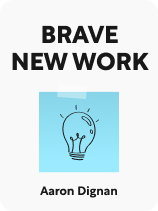

This article is an excerpt from the Shortform book guide to "Brave New Work" by Aaron Dignan. Shortform has the world's best summaries and analyses of books you should be reading.
Like this article? Sign up for a free trial here.
Are you making big changes at work? What’s the easiest way to implement change in an organization?
Change is normal for any organization, but everybody has to be on the same page. That’s why Aaron Dignan’s book Brave New Work gives key advice on making changes as smooth as possible.
Keep reading for the key to implementing change in an organization.
Strategies for Implementing Change
Once you’ve set the stage for reform by establishing psychological safety and a consent process at work, you’re ready for a plan on implementing change in an organization to combat disillusionment and inefficiency at work. Each of these strategies aims to incorporate his foundational principles of autonomy and flexibility into your organization.
1. Define a Unifying Purpose
Defining a unifying purpose is an essential step in establishing autonomy and flexibility because it enables cohesive work in a decentralized context. This should be a group effort (ideally using the consent process) to determine the overall purpose of the work, who your purpose serves, and how the purpose could be changed in the future if needed.
As individuals and groups gain the freedom to act autonomously, the unifying purpose should guide decisions and determine what organizational changes are needed. Metrics can be used to determine if the work is aligned with the unifying purpose, but not necessarily as a measure of success.
For example, if your organization’s purpose is to make access to clean water more equitable, members can use statistics on the number of new wells installed as a helpful indicator without it becoming the sole focus. Natural disasters may set back the efforts to install wells, new and improved technologies may emerge, or employees may find other innovative ways to work toward the goal of equitable water access.
2. Distribute Authority Widely
For the principles of autonomy and flexibility to be effective in your organization, authority is another important area to reform. In general, Dignan recommends giving people the power to carry out the organization’s purpose the best way they see fit, rather than workers simply following orders from a superior. Regular governance meetings and allocating resources as needed are a couple of specific ways to distribute authority.
A regular governance meeting creates a democratic space for everyone to implement the consent process discussed in the previous section. In these meetings, everyone has the authority to propose changes to structures and processes or to raise concerns about anything inhibiting their work. If your organization already has a lot of meetings, Dignan also recommends canceling all meetings for two weeks to give everyone a chance to figure out what meetings are genuinely helpful. People can then return to the governance meeting with a new perspective on what changes they want to see and what processes they want to maintain.
(Shortform note: Applied in a different context, governance meetings within families enable a more democratic style of parenting, as opposed to an authoritarian style (where parents set strict rules) or a permissive style (where children can do what they want). In democratic parenting, governance meetings are an opportunity for each family member to have a voice and weigh in on activities, household rules, and allowances. Similar to Dignan’s benefits of an autonomous workplace, advocates of this practice argue that it fosters feelings of connection, worthiness, autonomy, and courage in children.)
Since control of resources is another way to exercise authority, allowing workers to allocate resources as needed is another way to distribute authority. Rather than adhering to a rigid, traditional budget that controls the flow of resources, Dignan suggests maximizing discretionary funds and the number of people who have access to them.
3. Create Dynamic Teams
Creating dynamic teams gives individuals and groups within the organization the autonomy to get work done quickly as self-sufficient units (while still being united by the group’s overall purpose). Dignan argues that individuals should not be tied to a specific job title and should instead have the flexibility to join multiple teams based on their interests and desire to contribute toward the overall purpose. This results in a network of dynamic roles rather than a traditional organization chart with fixed and limiting positions.
One strategy for creating dynamic teams is to experiment with what Dignan calls SLAM teams:
- Self-managed: The team doesn’t have to provide progress updates or receive instructions from a higher-up.
- Lean: The group is small enough to make decisions and mobilize quickly.
- Audacious: The team can pursue bold activities unencumbered by outside leadership.
- Multidisciplinary: The team has the skill set to achieve its goal.
4. Practice Looping Continuously
The last strategy for achieving autonomy and flexibility is to practice “looping.” The process of looping involves experimenting with new practices and assessing how well they work for your group.
It incorporates Dignan’s principle of autonomy by giving people the responsibility for identifying areas they’d like to improve and potential strategies for making changes. It also embodies the principle of organizational flexibility because it allows you to quickly iterate different ways of doing things. Dignan suggests that looping should be frequent and ongoing to facilitate constant progress. Notably, looping can involve eliminating processes in addition to adding new ones.
Looping includes the following steps:
- Observe areas for improvement.
- Propose a new system or strategy to experiment with. Clarify details such as the timeframe and people involved.
- Conduct the experiment.
- Reflect on what went well and what didn’t work well, then repeat.

———End of Preview———
Like what you just read? Read the rest of the world's best book summary and analysis of Aaron Dignan's "Brave New Work" at Shortform.
Here's what you'll find in our full Brave New Work summary:
- How organizations can adapt to the rapid pace of change in the modern world
- Why old organizational structures don't work anymore
- How to enable organizations to run themselves through decentralized work






